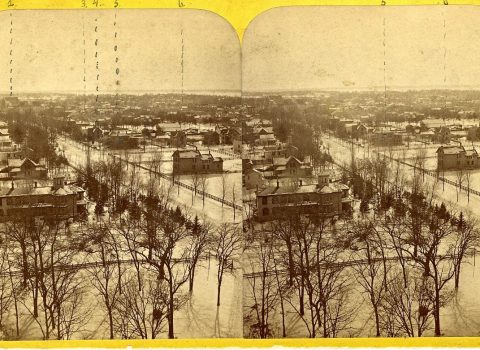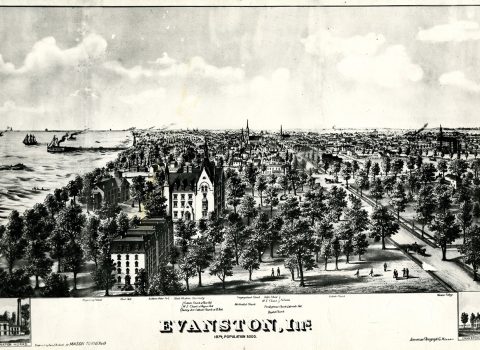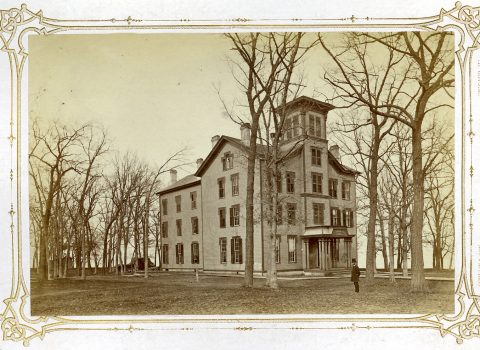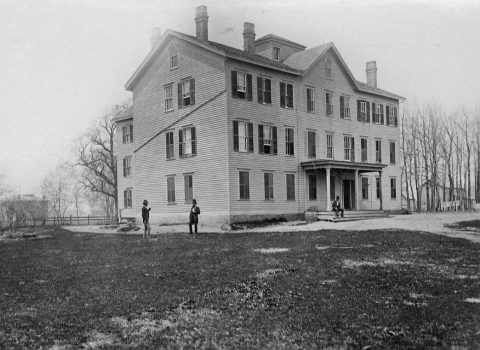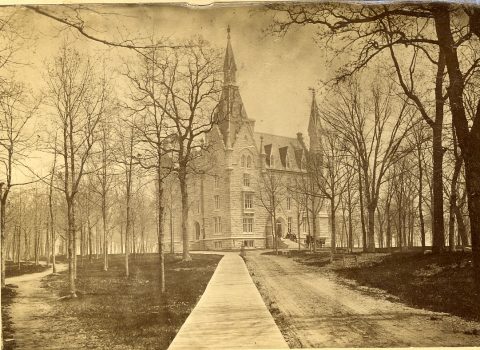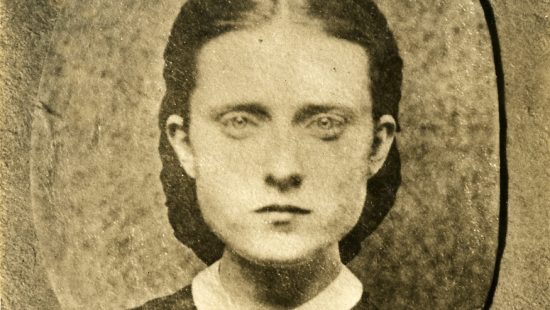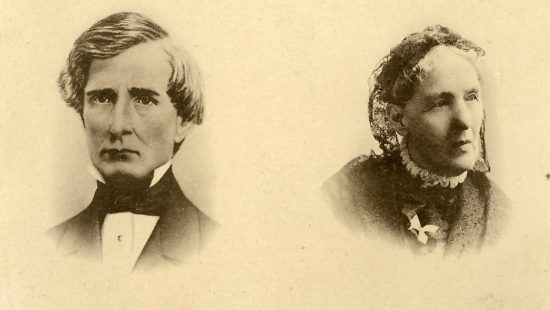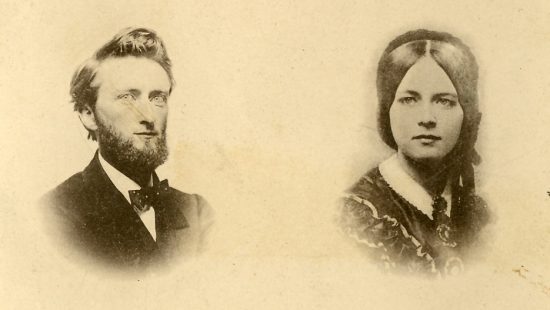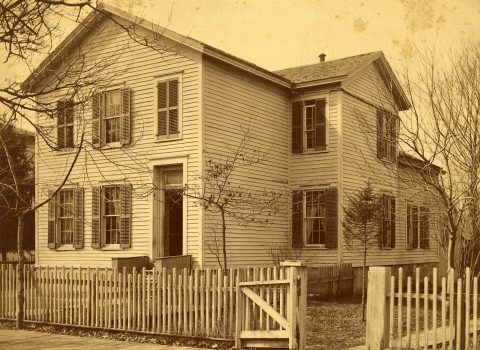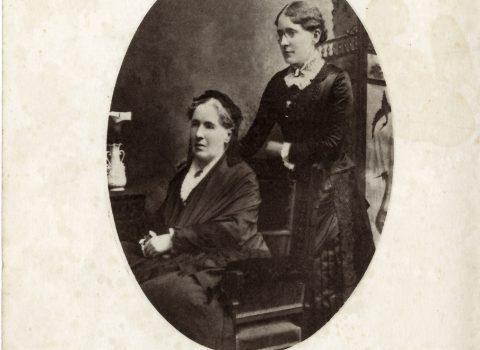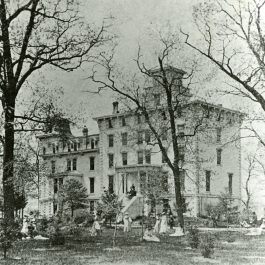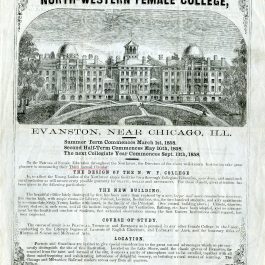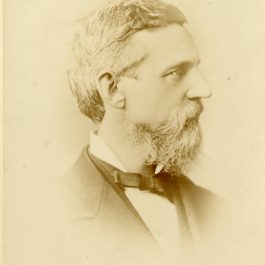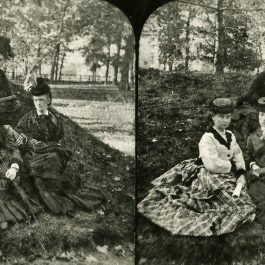Early life: 1858-1860
Frances Willard and Evanston grew up together. In 1858, at the age of 19, she and her younger sister, Mary, came from their family’s home in Wisconsin to attend the North Western Female College as boarding students. The rest of the Willard family moved to Evanston the next year. They found a congenial home in the vibrant community, growing up around three academic institutions (Northwestern University, Garrett Biblical Institute, and the Female College). Methodism was the tie that bound many of Evanston’s families to the young village, which offered an unusual blend of intellectual activity, religious conviction, and social conscience (abolitionist, pro-temperance) on the fringes of the bustling commercial center of Chicago. The social experiment that was Evanston provided a natural setting for Willard’s own first steps as a speaker, organizer, and leader.
Evanston and Northwestern
Early Evanston was shaped by the University in many ways—including the layout of the town itself. Northwestern’s founders had purchased and platted the land so that the sale or rental of plots would finance the University. Evanston became particularly attractive to Methodist residents when the University’s charter was amended in 1855 to exclude the sale of liquor within four miles of the campus.
When Frances Willard came to Evanston in 1858, the single building containing Northwestern University’s classrooms, chapel, and offices was located at the corner of Davis Street and Hinman Avenue. The only structure on what is now the Northwestern campus was Dempster Hall, housing the Garrett Biblical Institute. University Hall (described by Willard as “a poem in stone”) was built in 1869.
The Old First Methodist Church
Willard friends’ and neighbors’ lives centered around the First Methodist Church. She benefited from the sermons of the ministers, and from the support and examples set by the Methodist women she met—both older and of her own generation.
The church originally stood at the corner of Church Street and Orrington Avenue (where the Evanston Public Library is now), right around the corner from the Willard home on Chicago Avenue, from 1856-1872.
The new church was built at Church and Hinman between 1870-1874. It stood until 1909.
Frances Willard, circa 1858-9
Willard at the age of her arrival in Evanston. No photographer identified. Modern enlarged print; the original is probably from the Northwestern Female College autograph book. On loan from the Frances Willard Memorial Library & Archives; original in Frances Willard Collection, Northwestern University Archives.
Frances's parents
Josiah Flint Willard (1805-1868) and Mary Thompson Hill Willard (1805-1892). Frances Willard’s parents, depicted here as part of a photo montage titled “My Four.” Published in Willard’s autobiography, Glimpses of Fifty Years (1889). Modern scan from the image in the book.
Willards in Evanston
When Willard’s parents, Josiah and Mary Willard, followed their daughters to Evanston in 1859, they rented a house-known as Swampscot-on Northwestern University-owned land at the southwest corner of Church and Judson Streets. The eldest child, Oliver, attended the Garrett Biblical Institute, where he was a classmate of future Northwestern University president Charles Fowler. Frances’s sister, Mary, died in 1862, and in 1865 the Willards moved into a newly built home on Chicago Avenue. As at Swampscot, their neighbors were ministers, Northwestern University faculty, and civic leaders of Evanston. Josiah Willard died in 1868; then, after Oliver Willard’s death, ten years later, Mrs. Willard added an annex to the north side for his widow and their children, creating the double house still standing today at 1730 Chicago. “Rest Cottage,” as Frances Willard called it, remained her beloved home until her death.
The North-Western Female College
The North-Western Female College opened in 1855—the same year as the University, but not affiliated with it—by William P. Jones, a strong advocate of higher education for women. Willard found a congenial environment at the Female College. She wrote poetry for the Casket and Budget, the College’s newspaper, which the girls claimed as the first newspaper in Evanston. She and another girl were the sole members of the graduating class of 1859 (Willard was named valedictorian and her classmate salutatorian).
More Information
This exhibit features items from Northwestern University Archives (NUA)
and the Frances Willard House Museum & Archives (FWHA).

